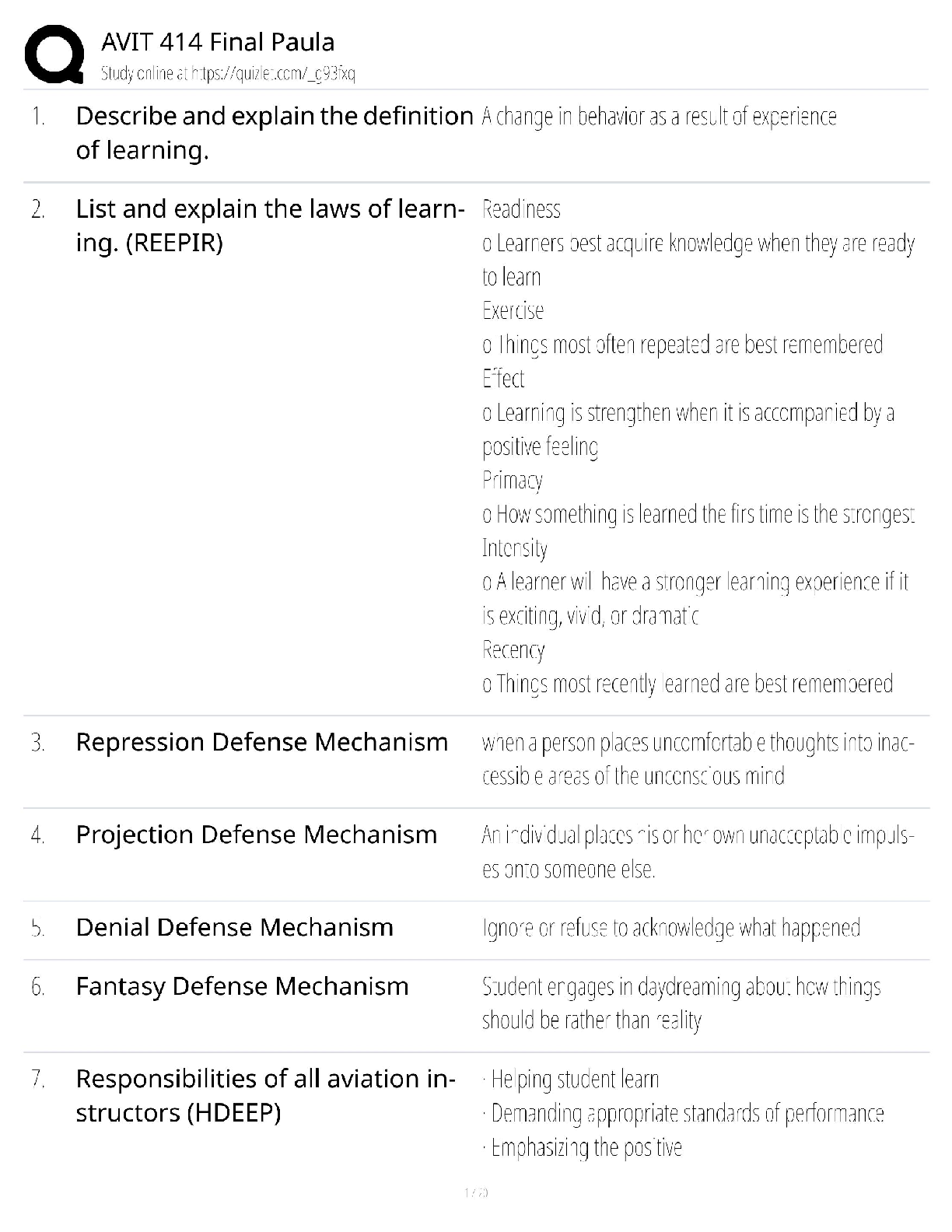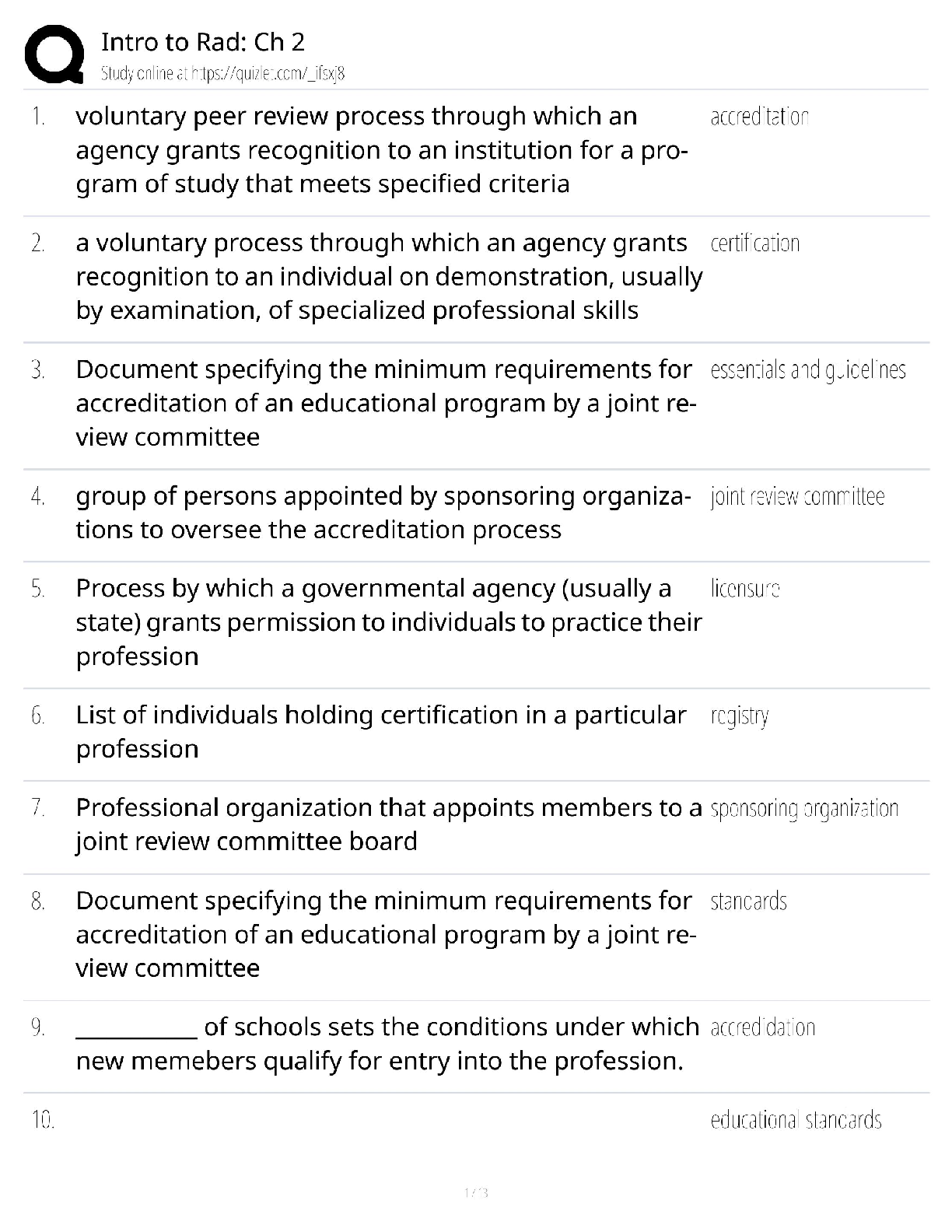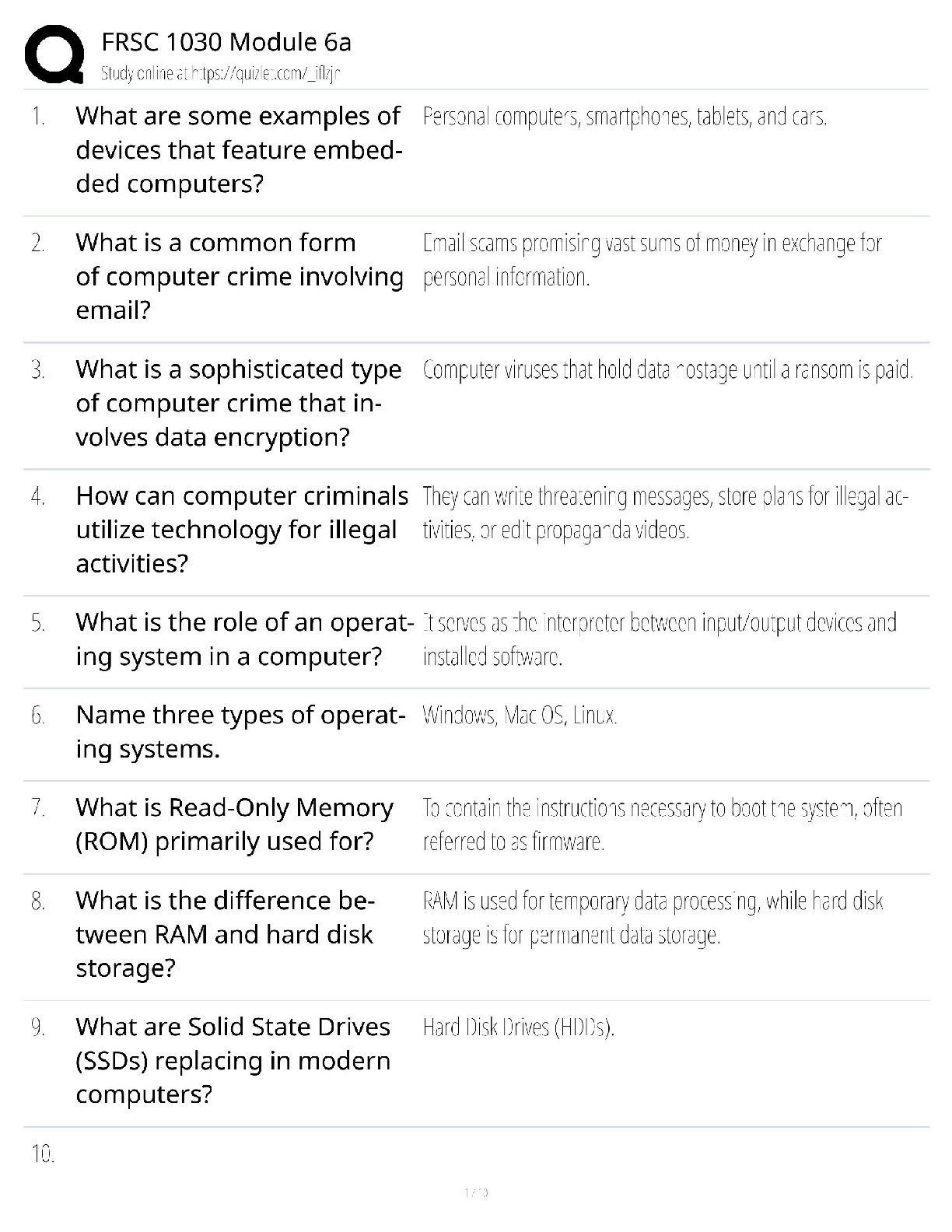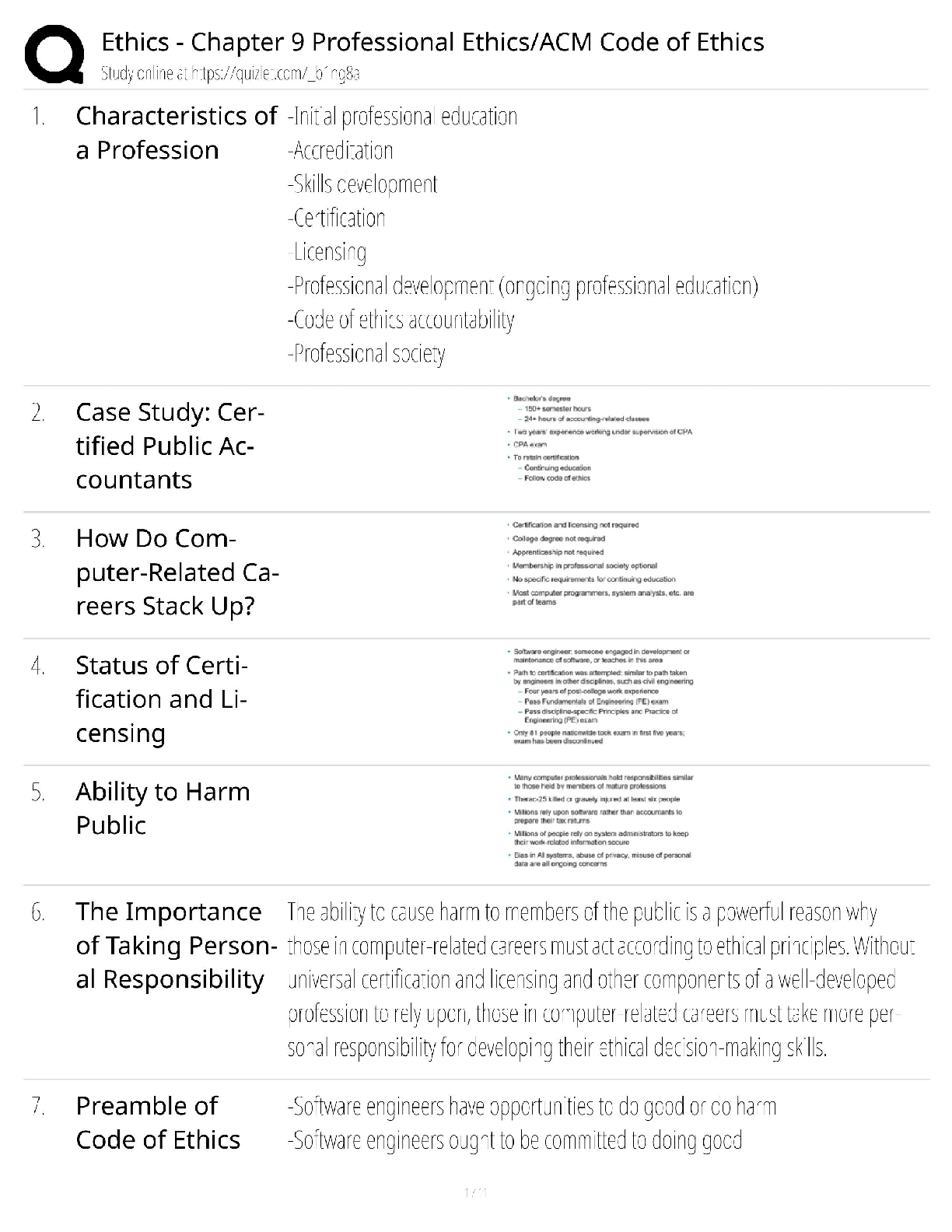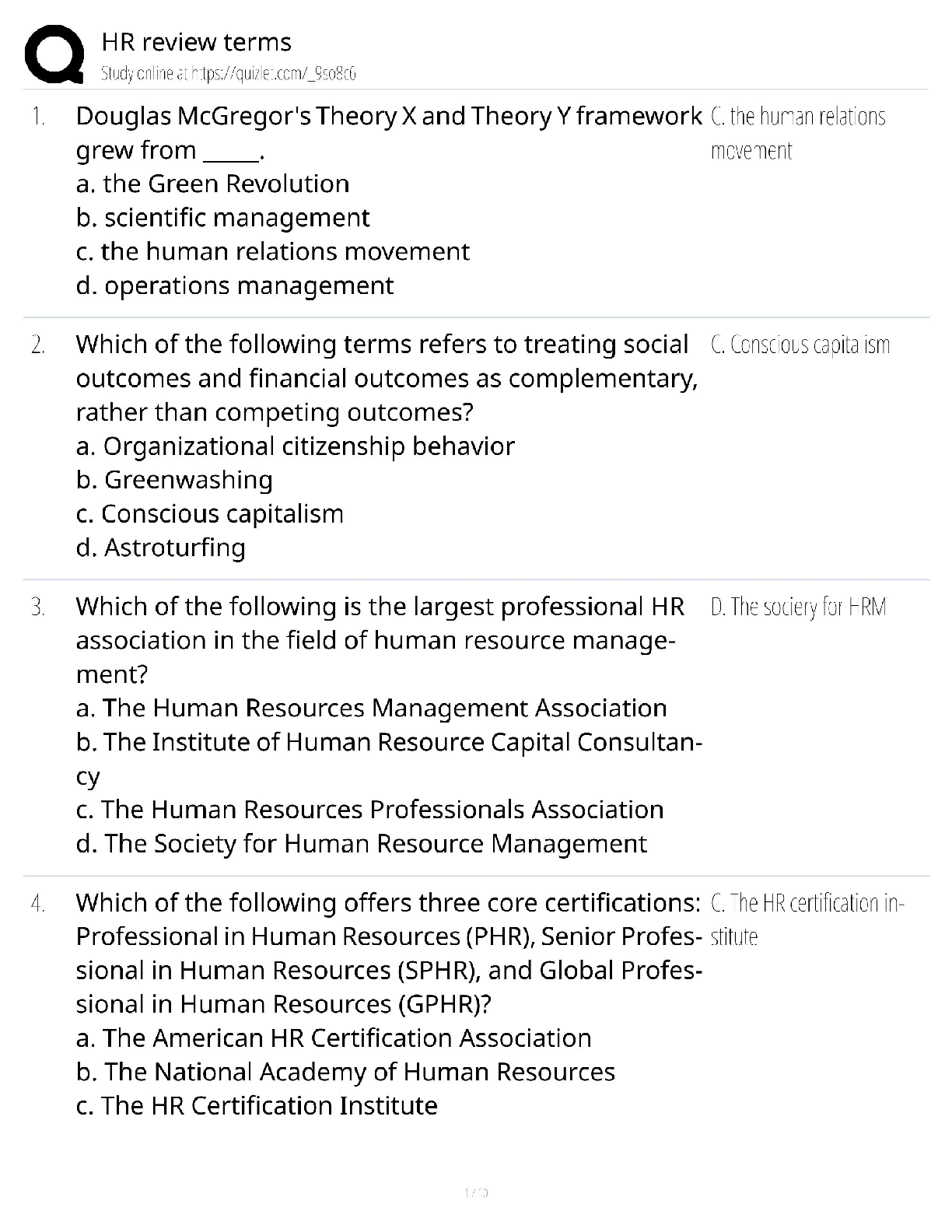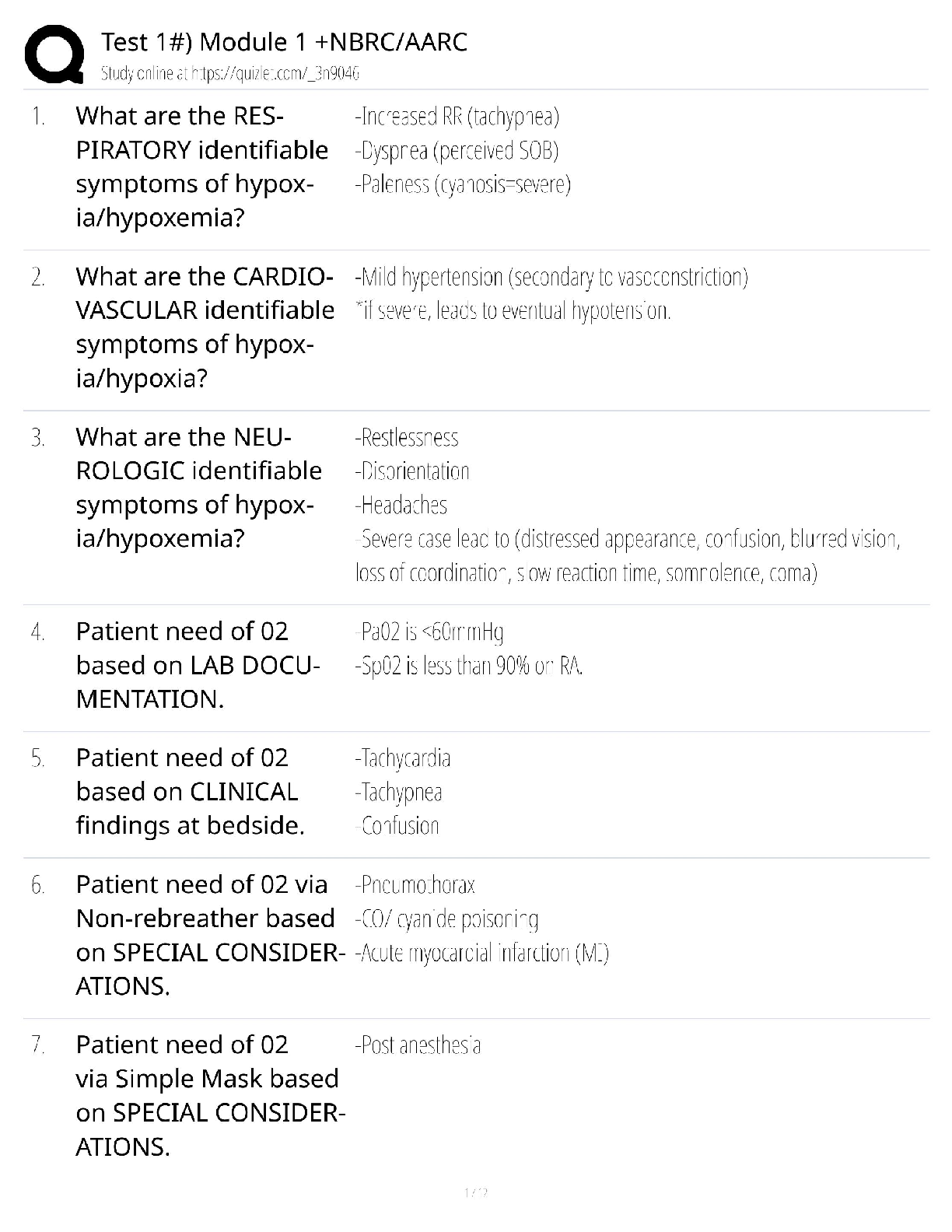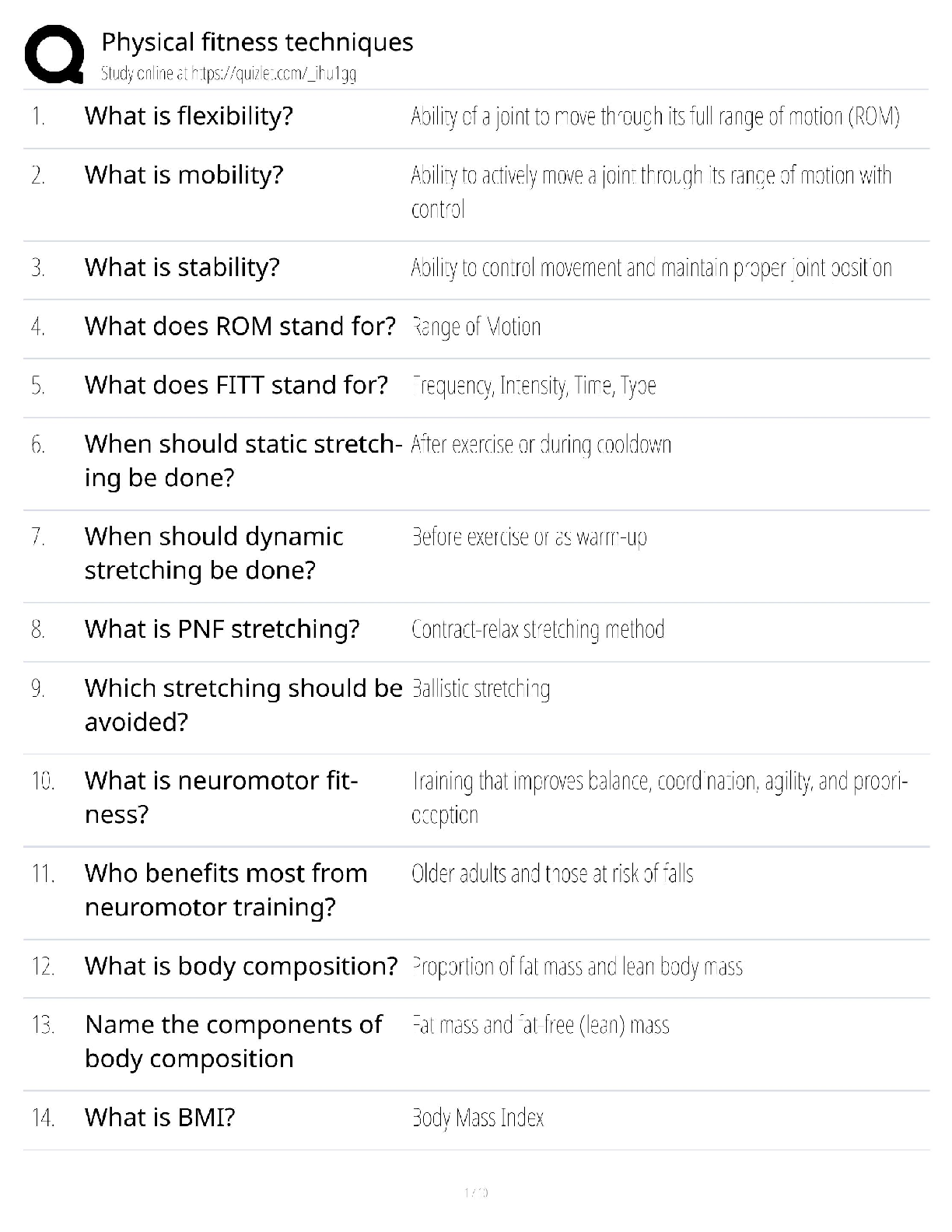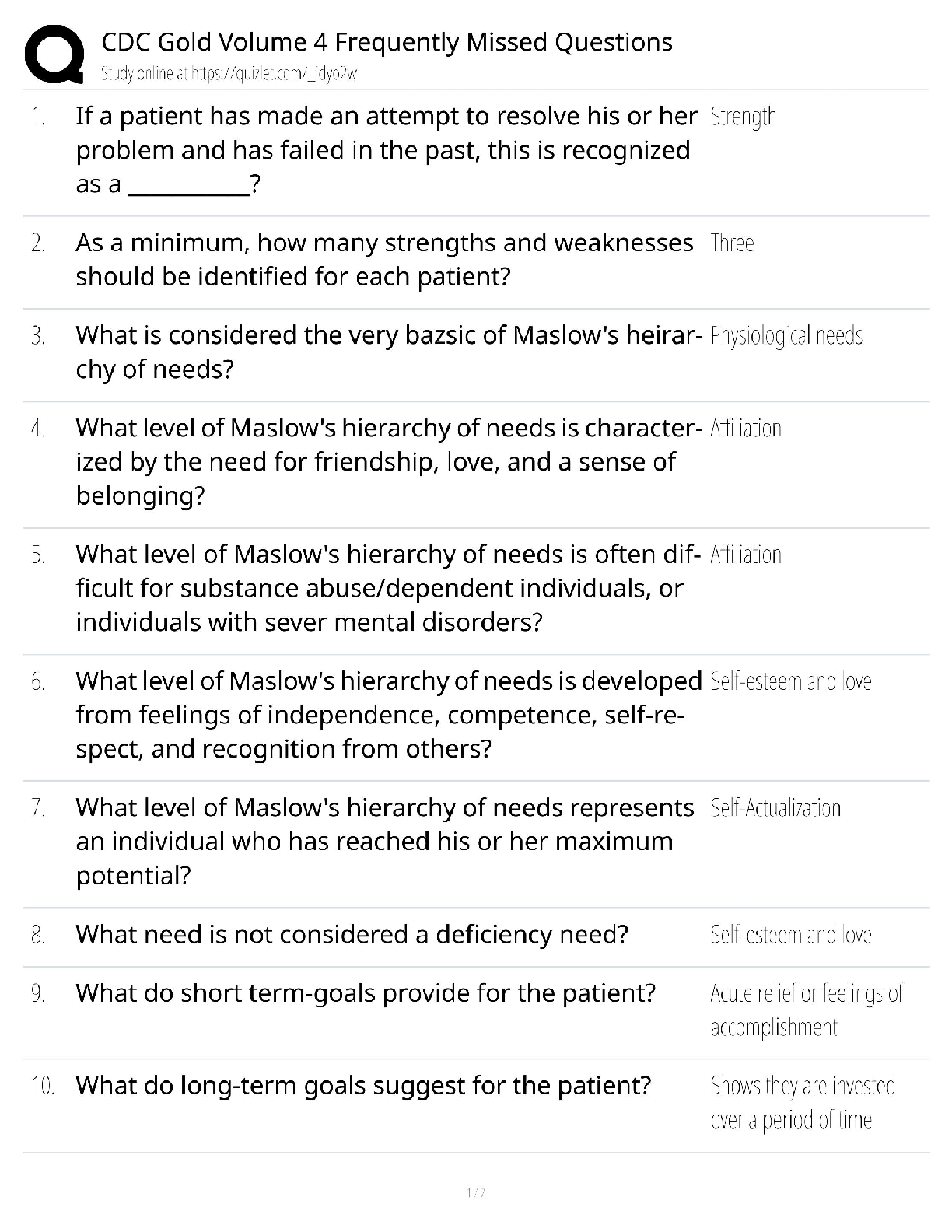Financial Accounting > QUESTIONS & ANSWERS > UCI Econ 13/IS13: Midterm Questions and Answers (All)
UCI Econ 13/IS13: Midterm Questions and Answers
Document Content and Description Below
Multiple Choice Identify the choice that best completes the statement or answers the question. _d_c__ 1. Low rates of inflation are generally associated with a. low rates of government spending. ... b. small or nonexistent government budget deficits. c. low rates of productivity growth. d. low rates of growth of the quantity of money. __b__ 2. In the circular-flow diagram, a. profit flows from households to firms. b. labor flows from households to firms. c. services flow from households to firms. d. All of the above are correct. __b__ 3. When an economy is operating at a point on its production possibilities frontier, then a. consumers are content with the mix of goods and services that is being produced. b. there is no way to produce more of one good without producing less of the other. c. equal amounts of the two goods are being produced. d. All of the above are correct. __b__ 4. Which of the following trade-offs does the production possibilities frontier illustrate? a. if an economy wants to increase efficiency in production, then it must sacrifice equality in consumption b. once an economy has reached the efficient points on its production possibilities frontier, the only way of getting more of one good is to get less of the other c. for an economy to consume more of one good, it must stop consuming the other good entirely d. for an economy to produce and consume goods, it must sacrifice environmental quality Figure 2-3 __d__ 5. Refer to Figure 2-3. Inefficient production is represented by which point(s)? a. J, L b. J, L, M c. K, N d. M __d__ 6. Refer to Figure 2-3. Unemployment could cause this economy to produce at which point(s)? a. J, L b. J, L, M c. K, N d. M Figure 2-8 Panel (a) Panel (b) __a__ 7. Refer to Figure 2-8, Panel (a). The opportunity cost of moving from point M to point L is a. 2 donuts. b. 2 donuts and 4 cups of coffee. c. 4 donuts. d. 4 cups of coffee. _d_b__ 8. Which of the following would likely be studied by a macroeconomist rather than a microeconomist? a. the effect of an increase in the cigarette tax on smokers b. the effect of foreign competition on the domestic textile industry c. the effect of a war on automobile prices d. the effect of an increase in the minimum wage on an economy’s overall rate of unemployment __c__ 9. A group of buyers and sellers of a particular good or service is called a(n) a. coalition. b. economy. c. market. d. competition. __d__ 10. “Other things equal, when the price of a good rises, the quantity demanded of the good falls, and when the price falls, the quantity demanded rises.” This relationship between price and quantity demanded a. applies to most goods in the economy. b. is represented by a downward-sloping demand curve. c. is referred to as the law of demand. d. All of the above are correct. __d__ 11. The market demand curve a. is found by vertically adding the individual demand curves. b. slopes upward. c. represents the sum of the prices that all the buyers are willing to pay for a given quantity of the good. d. represents the sum of the quantities demanded by all the buyers at each price of the good. __d__ 12. You wear either shorts or sweatpants every day. You notice that sweatpants have gone on sale, so your demand for a. sweatpants will increase. b. sweatpants will decrease. c. shorts will increase. d. shorts will decrease. $8 2 12 8 20 $10 0 15 4 25 __b__ 13. Refer to Table 4-3. If these are the only four sellers in the market, then when the price increases from $6 to $8, the market quantity supplied a. increases by 0.5 unit. b. increases by 2 units. c. decreases by 4 units. d. increases by 42 units. _b_c__ 14. When quantity supplied increases at every possible price, we know that the supply curve has a. shifted to the left. b. shifted to th Other things equal, when the price of a good rises, the quantity demanded of the good falls, and when the price falls, the quantity demanded rises.” This e right. c. not shifted; rather, we have moved along the supply curve to a new point on the same curve. d. not shifted; rather, the supply curve has become flatter. Other things equal, when the price of a good rises, the quantity demanded of the good falls, and when the price falls, the quantity demanded rises.” This _c_b__ 15. Which of the following would shift the supply curve for gasoline to the right? a. An increase in the demand for gasoline. b. An increase in the price of gasoline. c. An increase in the number of producers of gasoline d. An increase in the price of oil, an input into the production of gasoline. Figure 4-6 __d__ 16. Refer to Figure 4-6. The movement from point A to point B on the graph represents a. an increased willingness and ability on the part of suppliers to supply the good at each possible price. b. an increase in the number of suppliers. c. a decrease in the price of a relevant input. d. an increase in the price of the good that is being supplied and suppliers’ response to that price change. __b__ 17. The law of supply and demand asserts that a. demand curves and supply curves tend to shift to the right as time goes by. b. the price of a good will eventually rise in response to an excess demand for that good. c. when the supply curve for a good shifts, the demand curve for that good shifts in response. d. the equilibrium price of a good will be rising more often than it will be falling. Table 4-8 An Increase in Supply A Decrease in Supply An Increase in Demand A B A Decrease in Demand C D __b__ 18. Refer to Table 4-8. Which space represents an increase in equilibrium price and an indeterminate change in equilibrium quantity? a. A b. B c. C d. D Figure 4-8 _b_c__ 19. Refer to Figure 4-8. At what price would there be an excess demand of 200 units of the good? a. $15 b. $20 c. $30 d. $35 Figure 4-14 Panel (a) Panel (b) Panel (c) Panel (d) __a__ 20. Refer to Figure 4-14. Which of the four panels represents the market for pizza delivery in a college town as we go from summer to the beginning of the fall semester? a. Panel (a) b. Panel (b) c. Panel (c) d. Panel (d) _d___ 21. If the demand for a product decreases, then we would expect a. equilibrium price to increase and equilibrium quantity to decrease. b. equilibrium price to decrease and equilibrium quantity to increase. c. equilibrium price and equilibrium quantity to both increase. d. equilibrium price and equilibrium quantity to both decrease. __d__ 22. Suppose the number of buyers in a market increases and a technological advancement occurs also. What would we expect to happen in the market? a. Equilibrium price would decrease, but the impact on equilibrium quantity would be ambiguous. b. Equilibrium price would increase, but the impact on equilibrium quantity would be ambiguous. c. Equilibrium quantity would decrease, but the impact on equilibrium price would be ambiguous. d. Equilibrium quantity would increase, but the impact on equilibrium price would be ambiguous. __a__ 23. Brock is willing to pay $400 for a new suit, but he is able to buy the suit for $350. His consumer surplus is __d__ 24. Which of the following will cause a decrease in consumer surplus? a. an increase in the number of sellers of the good b. a decrease in the production cost of the good c. sellers expect the price of the good to be lower next month d. the imposition of a binding price floor in the market __b__ 25. Dallas buys strawberries, and he would be willing to pay more than he now pays. Suppose that Dallas has a change in his tastes such that he values strawberries more than before. If the market price is the same as before, then a. Dallas's consumer surplus would be unaffected. b. Dallas's consumer surplus would increase. c. Dallas's consumer surplus would decrease. d. Dallas would be wise to buy fewer strawberries than before. Figure 7-11 __d__ 26. Refer to Figure 7-11. Area A represents a. producer surplus to new producers entering the market as the result of an increase in price from P1 to P2. b. the increase in consumer surplus that results from an upward-sloping supply curve. c. the increase in total surplus when sellers are willing and able to increase supply from Q1 to Q2. d. the increase in producer surplus to those producers already in the market when the price increases from P1 to P2. __c__ 27. Refer to Figure 7-11. When the price falls from P2 to P1, which of the following would not be true? a. The sellers who still sell the good are worse off because they now receive less. b. Some sellers leave the market because they are not willing to sell the good at the lower price. c. The total cost of what is now sold by sellers is actually higher than it was before the decrease in the price. d. Producer surplus would fall by area A + B. __b__ 28. Total surplus is a. the total cost to sellers of providing the good minus the total value of the good to buyers. b. the total value of the good to buyers minus the cost to sellers of providing the good. c. the difference between consumer surplus and sellers’ cost. d. always smaller than producer surplus. Figure 7-16 _a___ 29. Refer to Figure 7-16. If the price were P3, consumer surplus would be represented by the area __d__ 30. In a simple circular-flow diagram, a. households spend all of their income. b. all goods and services are bought by households. c. expenditures flow through the markets for goods and services, while income flows through the markets for the factors of production. d. All of the above are correct. _c_d__ 31. Gross domestic product is defined as a. the quantity of all final goods and services demanded within a country in a given period of time. b. the quantity of all final goods and services supplied within a country in a given period of time. c. the market value of all final goods and services produced within a country in a given period of time. d. Both (a) and (b) are correct. __d__ 32. Which of the following transactions adds to U.S. GDP for 2006? a. In 2006, Marvin Windows manufactures 20 windows that will eventually be installed in an office building in Minneapolis. The windows remain in Marvin’s inventory at the end of 2006. b. An Irish marketing consultant works in Boston during the summer of 2006 and earns $30,000 during that time. c. When Tim and Tina were both single, they lived in separate apartments and each paid $750 in rent. Tim and Tina got married in 2006 and they bought a house that, according to reliable estimates, could be rented for $1,550 per month. d. All of the above transactions add to U.S. GDP for 2006. _a_b__ 33. A U.S. publisher purchases new computers that were manufactured in the U.S. This purchase by itself makes a. a positive contribution both to investment and to GDP. b. a positive contribution both to consumption and to GDP. c. a positive contribution to GDP, but it does not affect investment or consumption. d. a positive contribution to investment, but it does not affect GDP. __d__ 34. If net exports is a negative number for a particular year, then a. the value of firms’ inventories declined over the course of the year. b. consumption exceeded the sum of investment and government purchases during the year. c. the value of goods sold to foreigners exceeded the value of foreign goods purchased during the year. d. the value of foreign goods purchased exceeded the value of goods sold to foreigners during the year. __c__ 35. Which of the following is correct? a. Nominal GDP never equals real GDP. b. Nominal GDP always equals real GDP. c. Nominal GDP equals real GDP in the base year. d. Nominal GDP equals real GDP in all years but the base year. Table 23-4 The table below contains data for the country of Dachsland, which produces only pretzels and books. The base year is 2005. Year Price __d__ 36. Refer to Table 23-4. In 2006, Dachsland’s a. nominal GDP was $585, real GDP was $660, and the GDP deflator was 88.6. b. nominal GDP was $585, real GDP was $670, and the GDP deflator was 87.3. c. nominal GDP was $760, real GDP was $660, and the GDP deflator was 115.2. d. nominal GDP was $760, real GDP was $670, and the GDP deflator was 113.4. __d__ 37. For purposes of calculating the CPI, the housing category of consumer spending includes the cost of a. shelter. b. fuel and other utilities. c. household furnishings and operation. d. All of the above are correct. __c__ 38. The CPI differs from the GDP deflator in that a. the CPI is a price index, while the GDP deflator is an inflation index. b. substitution bias is not a problem with the CPI, but it is a problem with the GDP deflator. c. increases in the prices of foreign produced goods that are sold to U.S. consumers show up in the CPI but not in the GDP deflator. d. increases in the prices of domestically produced goods that are sold to the U.S. government show up in the CPI but not in the GDP deflator. Scenario 24-3 Grant Gant was a doctor in 1944 and earned $12,000 that year. His daughter, Gretta Gant, is a doctor today and she earned $210,000 in 2005. The price index was 17.6 in 1944 and 184 in 2005. _b___ 39. Refer to Scenario 24-3. Gretta Gant’s 2005 income in 1944 dollars is a. $11,931.82. b. $20,086.96. c. $1,985,454.55. d. $2,195,454.55. __a__ 40. The nominal interest rate tells you a. how fast the number of dollars in your bank account rises over time. b. how fast the purchasing power of your bank account rises over time. c. the number of dollars in your bank account today. d. the purchasing power of your bank account today. __a__ 41. The consumer price index was 225 in 2006 and 234 in 2007. The nominal interest rate during this period was 6.5 percent. What was the real interest rate during this period? a. 2.5 percent b. 4.0 percent c. 6.76 percent d. 10.5 percent __c__ 42. Yves is an unpaid worker in his family’s bakery. The Bureau of Labor Statistics counts Yves as a. unemployed and in the labor force. b. unemployed and not in the labor force. c. employed and in the labor force. d. employed and not in the labor force. __b__ 43. Suppose that the adult population is 6 million, the number of employed is 3.8 million, and the labor-force participation rate is 70%. What is the unemployment rate? a. 6.7% b. 9.5% c. 10.5% d. 28% _a_c__ 44. Discouraged workers a. are counted as out of the labor force but should be counted as unemployed. b. are counted as unemployed but should be counted as out of the labor force. c. are correctly counted as out of the labor force. d. are correctly counted as unemployed. __a__ 45. Evidence from research studies by economists a. shows that increased unemployment benefits decrease the job search efforts of the unemployed. b. shows that increased unemployment benefits have virtually no effect on the job search efforts of the unemployed. c. shows that increased unemployment benefits increase the job search efforts of the unemployed. d. is conflicting on what increased unemployment benefits do to the job search efforts of the unemployed. _d___ 46. Which of the following is correct? a. There is consensus among economists that unions are good for the economy. b. There is consensus among economists that unions are bad for the economy. c. There is consensus among economists that, on net, unions have almost no impact on macroeconomic variables. d. There is no consensus among economists about whether unions are good or bad for the economy. Short Answer 47. Draw a production possibilities frontier showing increasing opportunity cost of hammers in terms of horseshoes. a. On the graph, identify the area of feasible outcomes and the area of infeasible outcomes. b. On the graph, label a point that is efficient and a point that is inefficient. c. On the graph, illustrate the effect of the discovery of a new vein of iron ore, a resource needed to make both horseshoes and hammers, on this economy. d. On a second graph, illustrate the effect of a new computerized assembly line in the production of hammers on this economy. 48. a. What is the difference between a "change in demand" and a "change in quantity demanded?" Graph your answer. b. For each of the following changes, determine whether there will be a change in quantity demanded or a change in demand. i. a change in the price of a related good ii. a change in tastes iii. a change in the number of buyers iv. a change in price v. a change in consumer expectations vi. a change in income 49. Answer each of the following questions about demand and consumer surplus. a. What is consumer surplus, and how is it measured? b. What is the relationship between the demand curve and the willingness to pay? c. Other things equal, what happens to consumer surplus if the price of a good falls? Why? Illustrate using a demand curve. d. In what way does the demand curve represent the benefit consumers receive from participating in a market? In addition to the demand curve, what else must be considered to determine consumer surplus? 50. GDP is defined as the market value of all final goods and services produced within a country in a given period of time. In spite of this definition, some production is left out of GDP. Explain why some final goods and services are not included. 51. List the three major problems in using the CPI as a measure of the cost of living. 52. The table below uses data for the year 2003 provided by the Bureau of Labor Statistics and adjusted to be comparable to U.S. data. All values are in thousands. Fill in the blank entries in the table. Country Adult Population Labor Force Employed Unemployed Unemployment Rate Labor-Force Participation Rate Japan 109,474 66010 62,510 3,500 53.02 -> 5.30 60.30 France 46803.69 26,870 24293 2,577 9.59 57.41 Germany 70,159 39,591 35754.63 3836.37 9.69 56.43 53. Why might a favorable change in the economy, such as technological improvement or a decrease in the price of imported oil, be associated with an increase in frictional unemployment? 54. Teenage unemployment is higher than unemployment of people ages 20 and over. Explain why economists would attribute at least part of this difference to minimum-wage laws. [Show More]
Last updated: 3 years ago
Preview 1 out of 16 pages

Buy this document to get the full access instantly
Instant Download Access after purchase
Buy NowInstant download
We Accept:

Reviews( 0 )
$9.00
Can't find what you want? Try our AI powered Search
Document information
Connected school, study & course
About the document
Uploaded On
Mar 12, 2020
Number of pages
16
Written in
All
Additional information
This document has been written for:
Uploaded
Mar 12, 2020
Downloads
0
Views
154


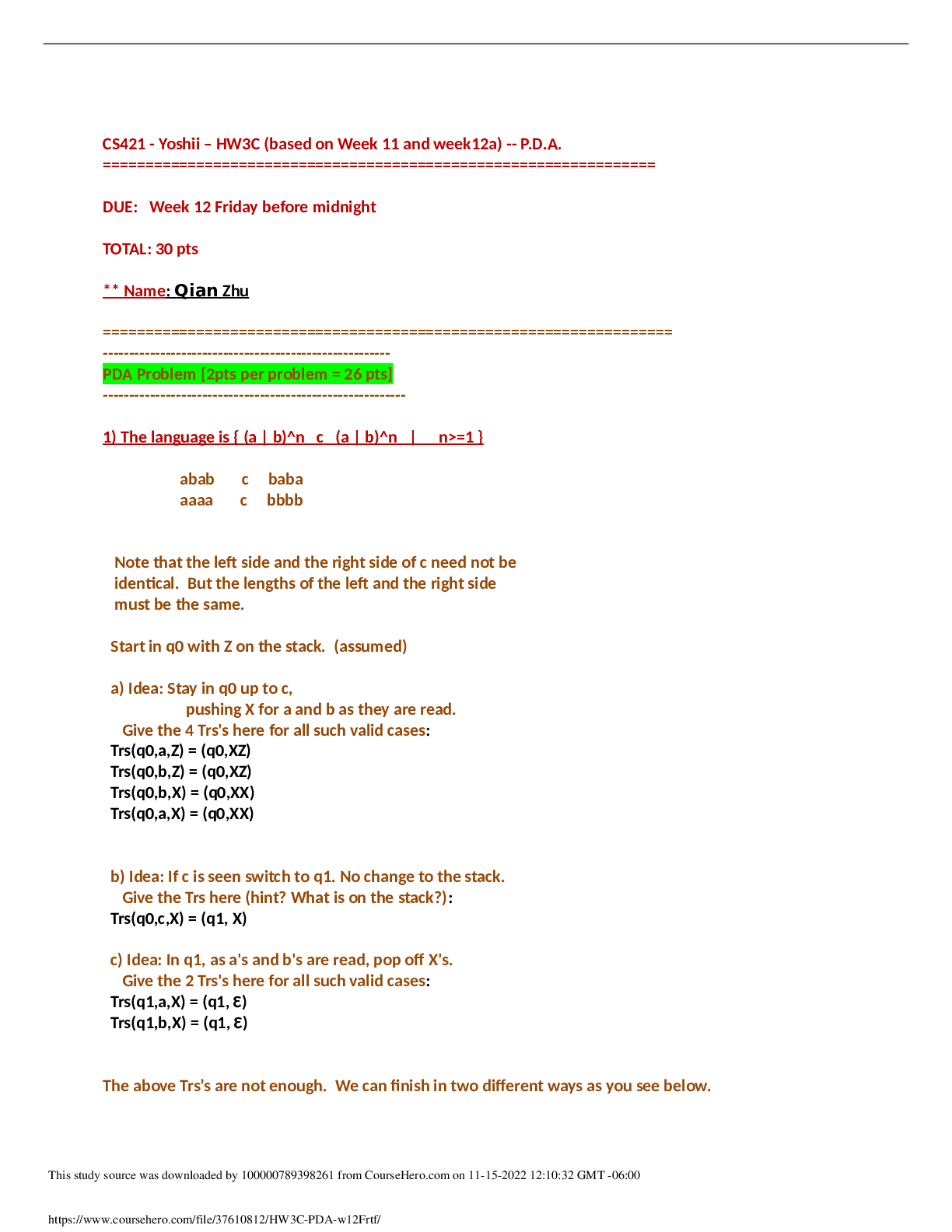


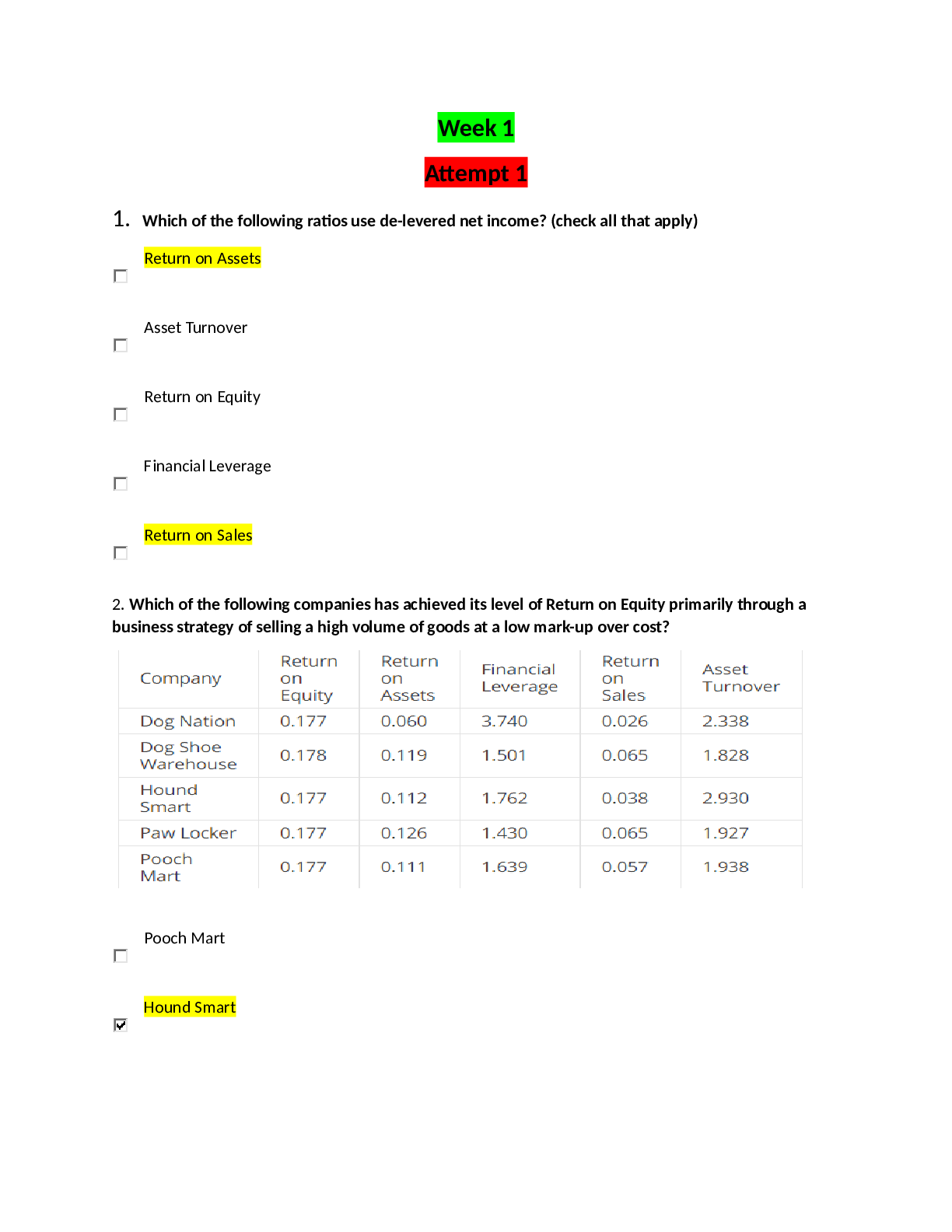
.png)
.png)
.png)
.png)
.png)
.png)
.png)
